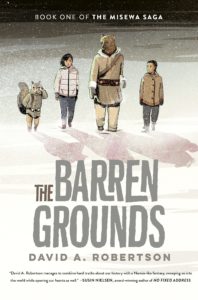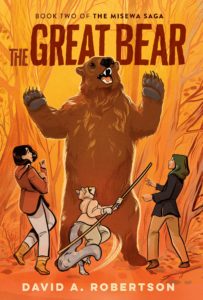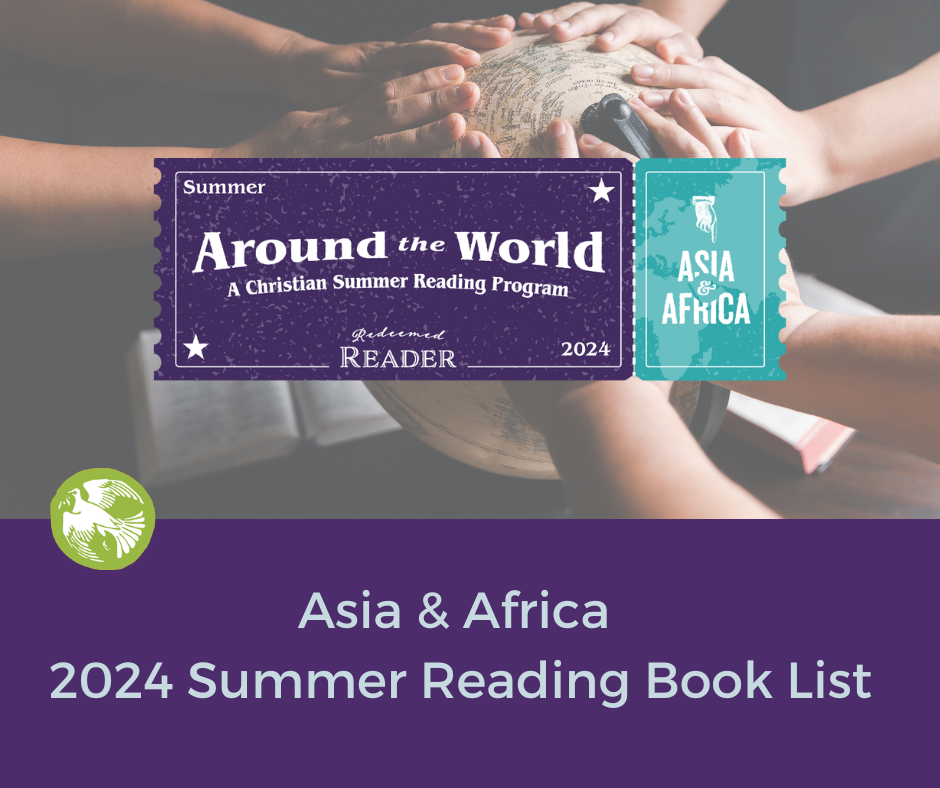Morgan and Eli find their way through an attic portal into a new land, Misewa, in this engaging series for middle grades.
The Barren Grounds and The Great Bear (Misewa Saga books 1 and 2) by David A. Robertson. Puffin Canada, 2020 and 2021. ~250 pages each

Reading Level: Middle grades, ages 10-12
Recommended For: Ages 10+ (note considerations)
What happens when two Indigenous children find themselves facing a portal out of their (white) foster home and into a new world? Well, they walk through it of course. Morgan and Eli are brother and sister by happenstance: both are living with the same white foster parents, James and Katie. Angry outbursts, difficulties fitting in at school, and feeling misunderstood are part and parcel of Morgan’s life by now, but Eli is only just learning how to navigate the world of foster care. Begrudgingly Morgan allows Eli to tag along to her secret place in the attic. To their amazement, Eli’s drawing comes to life and draws them from the attic to a new world, much as the picture in Eustace’s room comes to life in The Voyage of the Dawn Treader. Indeed, there is more than a living picture in common between The Misewa Saga and The Chronicles of Narnia!
Morgan and Eli find themselves in a wintry wood, met by a talking “fisher” (similar to a weasel) named Ochek. Ochek needs their help: his land is held captive in the White Time, and his people (all talking animals) are starving. Morgan and Eli accompany him to his longhouse, are accepted by the council, and promise to help Ochek find a way to end the White Time. Ochek’s community (Misewa) lives like Morgan and Eli’s traditional Indigenous Cree culture, and Eli especially welcomes this return to a normal life, far from his new school and foster family.
Morgan, Eli, and Ochek head to the trapline first; Ochek is the primary hunter feeding his community. When they catch Arik, a cheeky squirrel, stealing from the trapline, they grant her mercy in return for her knowledge of how to end the White Time. The four journey long and far on their quest. Weeks go by, but when Morgan and Eli return to their foster home through the attic portal, they find that mere hours have passed. Misewa time moves differently than Winnipeg time.

There is much to enjoy in these two books. For starters, it’s a delight to find engaging books about Native cultures that are good stories on their own and not merely historical fiction. The villain is a greedy white man, but the white foster parents are depicted as well meaning, even if they are a bit obtuse. Characters at school are also nuanced, with some friendly and some as bullies. Readers will learn some Cree words and customs, but the stories are quest adventures, not merely stories to teach a point. That being said, the books clearly portray Indigenous culture as more sustainable and kind than white culture (which may or may not be true, depending on the particular cultures in play). There is at least one animal labeled as a “they” since the children are uncertain of its gender. Traditionally, when we refer to animals with unknown genders, we use “it” because animals are not people. In today’s climate, it’s hard not to read into this character’s “they” label as a statement about gender fluidity. Otherwise, the characters all act like their stated gender.
In general, these are interesting, engaging reads that include fantasy elements reminiscent of Narnia. The first book can be read as a stand alone. The second ends on a cliffhanger! These would be great read alouds and jumping off points to talk about Native cultures and our tangled history. James and Katie’s well-meaning attempts to make Morgan and Eli backfire somewhat, but Morgan starts to realize that they really do want to help. Ask your kids how we do that: when do we try to help without first taking the time to understand what might actually BE helpful? How might we seek to understand those around us who come from different cultural backgrounds? When is something a cultural difference, and when is something a biblical issue?
Considerations:
- Language: Morgan has a gritty edge to her (understandable given her many foster homes), and she occasionally swears (“dammit”) or says “oh my g–“. Notably, it’s a lower-case “g.” The language use picks up in the second book.
- Religion: The animals pray to the Great Spirit, and Morgan references karma. She’s flippant about it, and it comes across like an average middle schooler tossing out phrases.
- The Great Bear is a heavier, edgier read: Eli is bullied in school for his long ponytail (significant in his culture), and Morgan is wrestling with whether to call her real mom or not once she finds her contact information. In addition, when the children return to Misewa, they learn of something that steals souls. The ending of the book is quite the cliffhanger, and it’s a bit dark.
- We cannot speak to the content of the third book (or any further books in the series). **Update: see comments below for information about the next book in the series.**
Overall Rating: 3.75 out of 5
- Worldview/Moral Rating: 3.75 out of 5
- Literary/Artistic Rating: 3.75 out of 5
Read more about our ratings here.
Related Reading From Redeemed Reader
- A Review: The Quest for Truth by Brock Eastman (another middle grades quest series, this time with Christian overtones)
- A Resource: Native American Traditional Tales (picture books that introduce traditional Native American legends, written by Native authors)
- A Resource: Here Be Dragons (our giant fantasy list!)
We are participants in the Amazon LLC affiliate program; purchases you make through affiliate links like the one below may earn us a commission. Read more here.
Final notes: tags should include ALL of the categories you checked plus publisher and anything else outstanding; Copy/paste title into the SEO keyword box, make sure the featured image is added, etc. Then, delete this paragraph!
Stay Up to Date!
Get the information you need to make wise choices about books for your children and teens.
Our weekly newsletter includes our latest reviews, related links from around the web, a featured book list, book trivia, and more. We never sell your information. You may unsubscribe at any time.
Support our writers and help keep Redeemed Reader ad-free by joining the Redeemed Reader Fellowship.
Stay Up to Date!
Get the information you need to make wise choices about books for your children and teens.
Our weekly newsletter includes our latest reviews, related links from around the web, a featured book list, book trivia, and more. We never sell your information. You may unsubscribe at any time.
We'd love to hear from you!
Our comments are now limited to our members (both Silver and Golden Key). Members, you just need to log in with your normal log-in credentials!
Not a member yet? You can join the Silver Key ($2.99/month) for a free 2-week trial. Cancel at any time. Find out more about membership here.
4 Comments
Leave a Comment
You must be logged in to post a comment.




Just wanted to leave a note for anyone who has not read the third book in the series yet (The Stone Child). I’m about 1/3 of the way through the book, and just passed this scene (I’m only including the pertinent sentences):
“Emily smiled at Morgan, and it made Morgan feel warm again, as if she were back in the dream. Emily leaned forward, kissed Morgan on her cheek, and Morgan thought hat maybe she hadn’t woken up after all . . . .
. . . Emily chuckled softly. ‘Was that okay?’
Morgan nodded. ‘Yes.’
. . . Her heart was racing from Emily’s kiss. Morgan took a deep breath . . . ”
It’s been building since the beginning of the book. Up until the heart racing, I tried to believe it was just affectionate tween girl friendship, especially in light of your recent review of Odder and the considerations of same-sex friendships (I do love me some Anne Shirley and Diana Barry, after all). I haven’t finished the book yet so can’t say if it will develop further than that, but just thought you should know. 🙂 Thanks, RR team, for all your work here!
Thank you, Christy! It’s helpful when our readers join us in “reading ahead” for folks!
Having finished the book, I can now confirm that while future physical contact is limited to holding hands, Morgan is thinking of Emily as her “best friend and maybe more.” Fyi. 🙂
Thank you, again, Christy! I know this will be helpful for our readers!